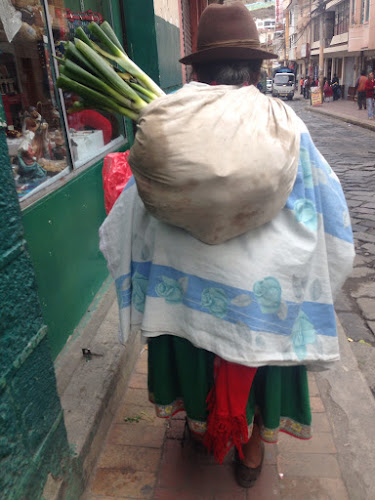When it comes to food provisions, I feel like I've become a time traveling anthropologist, touring the differing points on grocery's evolutionary curve.
High up on the altiplano she's called an 'artisanal', a western concept that offers images of specialist crafters, when the reality is necessity and survival. The Andiña pastoralist with her solitary, hand harvested milk cow, who crafts a simple boiled white cheese. A simple necessity, there's no milk-tanker collection service for raw milk. It's her sole cash crop. Now she has to stand in the bitter wind by the roadsides trying to sell to a disinterested passing public. Her only other alternative is to sell to an intermediary or travel to town on market day. And history is cluttered with rapacious middle-men and fickle markets. If it doesn't sell, she has costs but no income. Raw capitalism.
From road verge sale to the town market. In its basic form, ranked rows of steel poles canopied in polythene. Structures that can appear and disappear with sudden alacrity. Twenty tented structures, twenty vegetable sellers, twenty chances to buy the same identical produce. Raw competitive capitalism.
The temporary tent now evolves into bricks and mortar. Small dark caves where an eclectic selection of offerings are stacked deep and high. Move next door and the exact same offerings are available, only the random layout is different. And yet, what is interesting, the tent and the cave still survive when the basic supermarket opens across the road. In its essential form, the latter is just an enlarged form of the formers. A maxi-kiosk. It has more space for exactly the same offering. A larger display of toilet rolls.
Now grocer evolution evolves the 'hypermarket'. Western capitalist wisdom dictates that the tent, the cave, the kiosk, will simply wither away, swept aside by the hyper-efficient. We've cycled small town USA and witnessed the effect. Main Street with its' 'pay-day loans' and beauty nail-bars, dollar-shops and drawn shutters. Blind windows papered over with last year's news, these unrentables to be filled with 'op', 'thrift', or 'charity' shops. Alter the monetary denomination and I could be describing certain Scottish High Streets. Yet this scenario has yet to be enacted in the Andean towns and cities that we've visited.
Maybe the answer is walking towards me. A diminutive, determined matriarch bustling her persuasive way along the street. I step from the pavement so as not to impede her path; you wouldn't dare to argue with her. It's her street. It's her town. It's her country. It's her stall. It will survive.
Yet, all this grocery-anthropology leaves me with one question. The average height of an Andeña is well under 5' 5" (....), why is the top shelf in this hipermercado so far out of her reach?


